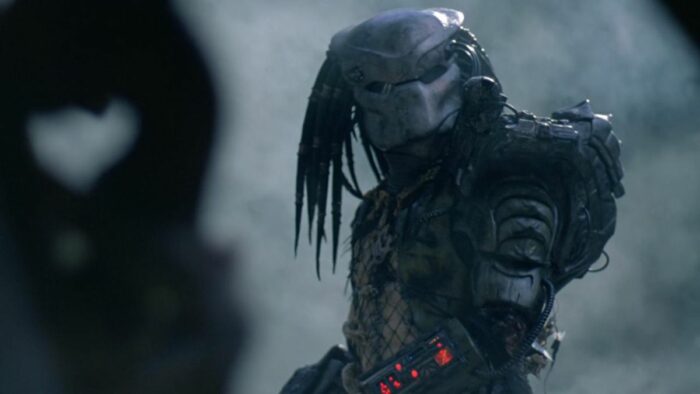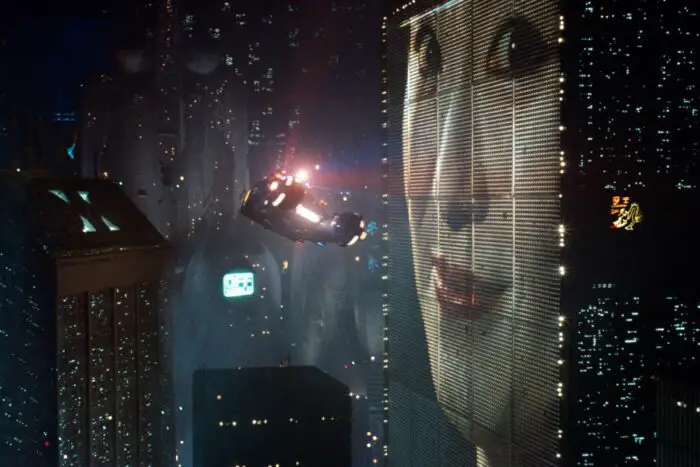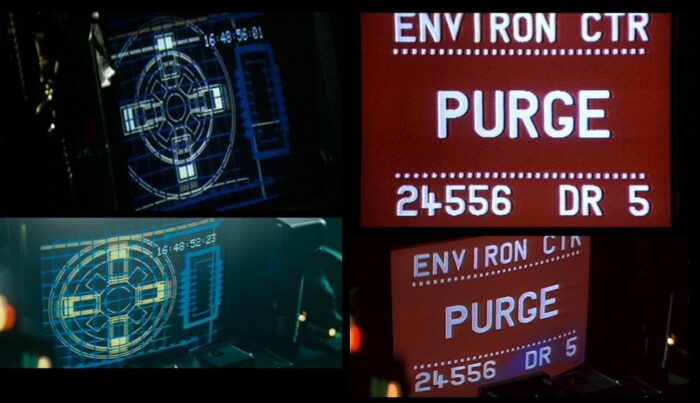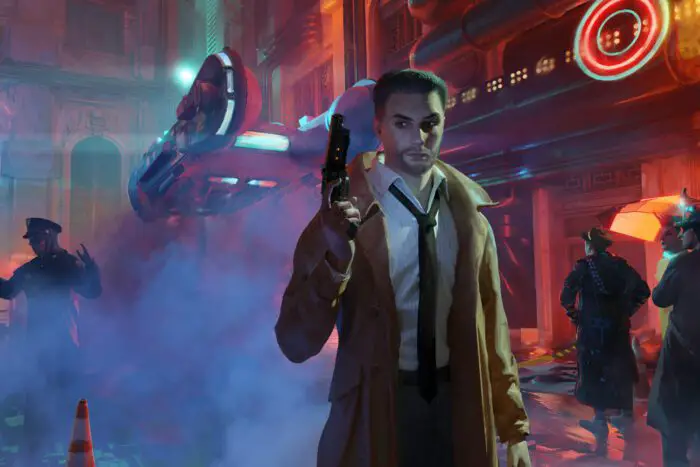The first Alien installment was released on May 25th, 1979. In the 43 years since its release, the franchise has given fans enough content to cover every inch of its Xenomorph-infested universe. As it stands today, the Alien franchise consists of the original film, three sequels, two AVP films, two prequels, 14 official short films, and a digital web series. These movie/TV installments each build off each other and introduce new ideas to the greater universe. However, multiple other famous movie franchises are confirmed to exist within the same cinematic universe. While some of these are more obvious—like the Predator movies—some are lesser known, like 1998’s Soldier. In this article, we’ll be looking at various connections between the Alien movies and other franchises to determine which are confirmed to be within the same universe and which are nothing more than easter eggs and cameos.
The Predator Franchise

The Predator franchise started in 1987 with John McTiernan’s Predator. The film quickly exploded in popularity, leading to the release of three sequels, a prequel, five official short films, and two crossovers with the Alien franchise. The first hint of this cinematic crossover can be found in 1990’s Predator 2. At the end of Predator 2, audiences are shown multiple skulls in a trophy case, including a large Xenomorph skull. This trophy case existed within this scene exclusively to show the various creatures that the Predators had defeated throughout history. This crossover was later cemented when AVP: Alien vs Predator hit theaters in 2004. Further, AVP was given a sequel in 2007 titled AVPR: Aliens vs Predator Requiem. Although neither of these crossover films takes place within the main Alien timeline, they do officially crossover with the franchise itself (and are still considered canon in the Predator’s main timeline).
The Blade Runner Franchise

The Blade Runner franchise started in 1982. The franchise has since received a sequel, three short films, and an animated television series. However, the original movie stood by itself for three and a half decades. Therefore, the connections to the Alien franchise mostly revolve around the original 1982 film. The first obvious connection comes from Ridley Scott, who directed both Blade Runner and Alien, giving both movies the atmosphere of a similar dystopian future. However, this was not a mere coincidence. Scott has gone on the record during a Blade Runner commentary saying, “So almost this world could easily be the city that supports the crew that go out in Alien. So, in other words, when the crew of Alien come back in, they might go into this place and go into a bar off the street near where Deckard lives. That’s how I thought about it.” If the word of Ridley Scott isn’t good enough, there are plenty of other connections. For example, the technology used in both Alien and Blade Runner shares similarities too. The purge screen that appears when Ripley begins releasing her escape pod is the same screen displayed when the flying cars in Blade Runner (called “Spinners”) lift off the ground.

If that connection isn’t good enough either, there are plenty more sprinkled throughout different bonus features on some physical media releases of the Alien franchise. The 20th anniversary DVD of Alien contained a bonus feature where you could read the profiles of each member of the Nostromo. Dallas’ profile notes that he used to work for the Tyrell Corporation, the corporation famous in Blade Runner for the creation of androids. Further, certain releases of Prometheus contain a similar bonus feature that details a memo from Mr. Weyland himself. His memo references his old mentor, noting that his mentor was “like a god, on top of a pyramid overlooking a city of angels.” His memo also detailed that he told his mentor to “stick with simple robotics instead of those genetic abominations he enslaved and sold off-world, although his idea to implant them with false memories was, well…‘amusing’ is how I would put it politely.” Although never referred to by name, everything in Peter Weyland’s memo suggests that his old mentor was Eldon Tyrell. With all the connections described here (including Ridley Scott’s personal views), it is safe to assume these worlds were meant to exist within the same universe. Just don’t expect to see Deckard fighting a Xenomorph anytime soon.
The Tommy Westphall Universe Hypothesis

Before we continue with this list, it is important to introduce a hypothesis that is crucial to the idea of expanding cinematic universes: The Tommy Westphall Universe Hypothesis. The hypothesis started with a sitcom from 1982 called St. Elsewhere. At the end of the series’ run, we find out that the events of the show were the product of one child’s imagination (Tommy Westphall). Therefore, any characters or items from St. Elsewhere that crossover with other shows swallows those shows into its own universe. If anyone from those secondary shows appears in other shows, those shows are also swallowed into the St. Elsewhere universe. As imaginable with more and more shows being made, Tommy’s shared universe expands at an exponential rate. The Tommy Westphall Universe Hypothesis is a very detailed and complex theory. The basic takeaway is that if Movie A shares a universe with Movie B and Movie B shares a universe with Movie C, Movie A and Movie C also share the same universe. With this being said, it’s time to discuss Paul W.S. Anderson’s Soldier.
Soldier (1998)

Soldier is one of the more surprising canon entries in the Alien franchise. This is because Soldier is said to take place in the same universe as Blade Runner. First, let’s look at the concept of Soldier. Soldier takes place in the year 2036 and follows an elite soldier named Sergeant Todd 3465. We follow Todd as he is dumped on a garbage planet by his military (who tried to have him executed during a training exercise). After arriving on the planet, Todd is rescued by a civilization that then treats his wounds and acknowledges him as part of the community. Later, when the planet is invaded by other soldiers who are told to treat civilians as hostile, Todd fights alongside the community in an attempt to bring down the entire military. How exactly is Soldier connected to Blade Runner? Well for starters, David Webb Peoples (a co-writer for Blade Runner and the only writer on Soldier) was quoted saying that he considered Soldier to be a “side-quel,” as it exists within the same universe.
In fact, the entire premise of the movie was based on the planned (but ditched) opening to Blade Runner. In this unused Blade Runner opening, audiences would’ve seen several replicants get dumped on an off-world colony. Looking at the movie itself, the events take place in the year 2036, 17 years after the events of Blade Runner. Characters within Soldier are also noted to have served in multiple battles that Roy Batty from Blade Runner mentions in his final monologue. Even further, the spinners from Blade Runner can also be seen throughout Soldier, with an abandoned one in clear view as soon as Todd gets dumped on the garbage planet. Besides these details and the writer’s views on the matter, there is also the fact that both Soldier and Blade Runner were released by Warner Brothers. Perhaps Deckard and Todd running into each other isn’t such a crazy idea after all!
What Order Should I Watch Them?
Franchise completionists typically have two schools of thought when it comes to the order a franchise is watched. This is especially true when looking at larger franchises, such as Star Wars or the MCU. Typically, franchises are either watched in the order each movie was released or chronologically. Here, we will give a list of both options. If you choose to watch the movies in the order they were released, you will be combining timelines. This is because while AVP is no longer considered canon to the Alien franchise, it is still considered canon to the Predator franchise. If you choose to watch the franchise in chronological order, the AVP movies will need to be watched separately.
Movies in Order of Release:
1. Alien (1979)
2. Blade Runner (1982)
3. Aliens (1986)
4. Predator (1987)
5. Predator 2 (1990)
6. Alien 3 (1992)
7. Alien Resurrection (1997)
8. Soldier (1998)
9. Alien vs. Predator (2004)
10. Aliens vs. Predator: Requiem (2007)
11. Predators (2010)
12. Prometheus (2012)
13. Alien: Covenant (2017)
14. Blade Runner 2049 (2017)
15. The Predator (2018)
16. Prey (2022)
Movies in Chronological Order:
1. Prey (2022)
2. Predator (1987)
3. Predator 2 (1990)
4. The Predator (2018)
5. Predators (2010)
6. Blade Runner (1982)
7. Soldier (1998)
8. Blade Runner 2049 (2017)
9. Prometheus (2012)
10. Alien: Covenant (2017)
11. Alien (1979)
12. Aliens (1986)
13. Alien 3 (1992)
14. Alien Resurrection (1997)
1. Alien vs. Predator (2004)
2. Aliens vs. Predator: Requiem (2007)
Possible Further Connections
So far, the Alien cinematic universe has crossed over with two other massive, blockbuster franchises. As can be imagined, many other movies reference these franchises through easter eggs, references, and sometimes even cameos. For example, a black spinner can be seen in the background of Back to the Future 2, and Doc Brown shows up with his DeLorean in A Million Ways to Die in the West. You can go further with this thread, noting that Django from Django Unchained shows up in A Million Ways to Die in the West. This does not mean that Django Unchained is considered a prequel to Alien, but it demonstrates how loose connections do not always connect cinematic universes. There are, however, a few connections that are widely debated within the fandom.
Firefly and Serenity

One of these connections comes from the 2002 series Firefly. In the first episode of Firefly, we witness the Battle of Serenity Valley. The only connection to the Alien franchise lies within the fact that a Weyland-Yutani logo can be seen on the screen of a UA 571-D sentry gun. Expanded Firefly lore claims that Weyland-Yutani is a weapons manufacturer, but besides this one connection, there is nothing on-screen to suggest it is more than an easter egg. Off-screen, however, it is worth mentioning that Joss Wheadon (the creator of Firefly) wrote the script for Alien Resurrection. Due to studio interference, Joss Wheadon’s script did not make it entirely into the final product. This has led some fans to speculate that his unused ideas for Alien Resurrection were transferred into Firefly. Whether or not you decide to watch the Firefly series and Serenity movie as part of your Alien binge is up to you. Until a creator or studio head steps up and definitively confirms whether or not they exist within the same universe, we will never truly know.
Underwater

Underwater is a very similar movie to Alien, both aesthetically and plot-wise. It follows a small group of characters who get trapped in their underwater vessel seven miles below the surface. Matters only get more complicated when a Lovecraftian creature starts chasing them. Similar to Firefly, the only on-screen connection to the Alien franchise is that a Weyland-Yutani logo can be seen on the strap of one character’s satchel. While this may seem like nothing more than an easter egg, the director (William Eubank) took to Twitter to share the little reference on Alien Day (April 26th). It is also worth mentioning that both Underwater and Alien are owned by 20th Century Fox. Perhaps if the movie had been a bigger box office success, the franchises would have crossed over at one point. For now, however, this reference remains a nod at a source of inspiration. There is also a big issue with this movie fitting into the Alien timeline. Underwater takes place in the year 2050, and the Weyland Yutani company was not created in the main Alien timeline until 2099. It is still possible that Underwater shares a universe with the AVP spin-offs, though this is highly unlikely, and there is very little evidence to suggest an official connection.
Other Media

The official franchises involved in the Alien franchise consist of Alien (of course), Predator, Blade Runner, and Soldier. However, this article only chronologically lists the order to watch every cinematically connected movie. Outside of feature-length films, there is still a lot of official content. Most notably, Blade Runner 2049 was released around the same time as three canon-confirmed short films. In 2021, we also got an animated series that served as a prequel to 2049 called Blade Runner: Black Lotus. The Alien main timeline also has official short films and a digital web series called Alien Isolation, which takes place 15 years after the original 1979 film. Depending on how deep you want to dive into the Alien universe, there are also a wide variety of graphic novels and video games that are officially licensed (and some are even considered canon to the main timeline). Unfortunately, due to the sheer size of the Alien/Predator/Blade Runner/Soldier universe, a complete list of all canon media deserves an article of its own.




You forgot in this awesome list Sean Connery´s Outland (1981)
Please elaborate?